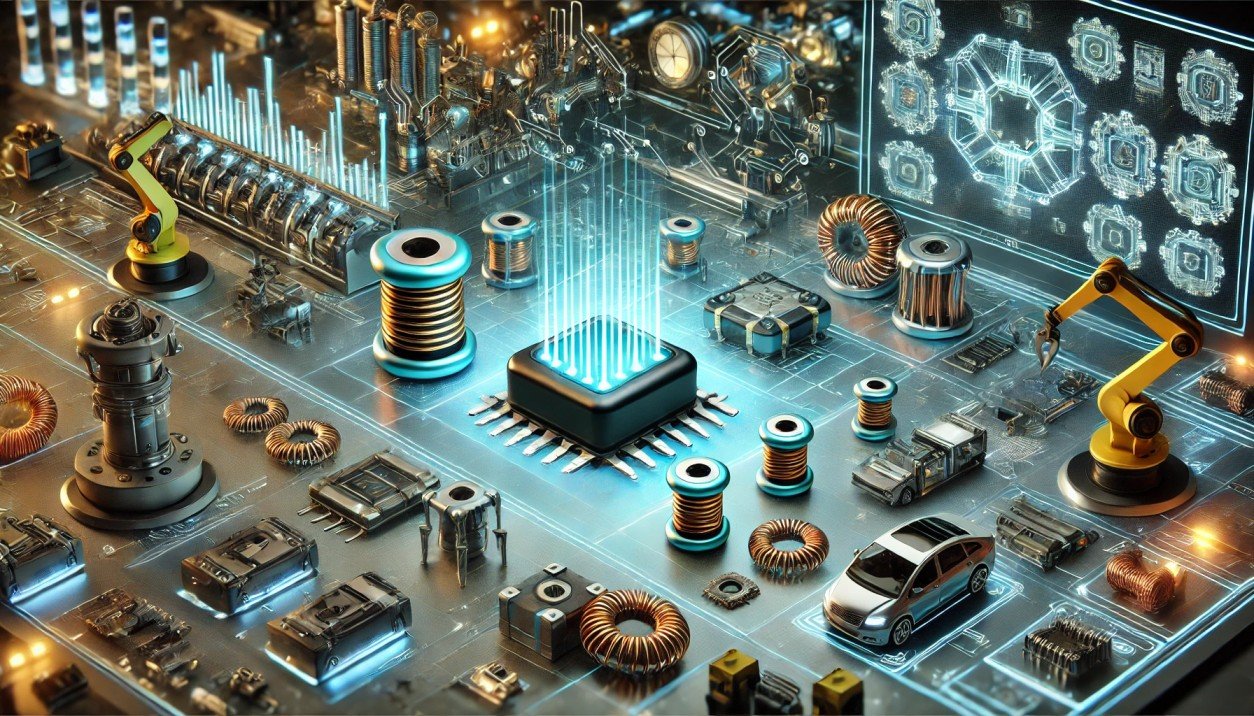Inductors have become important components in electronic circuits and are continuously changing with the increasing demand for higher-performance and smaller devices in these modern technological times. Advancement in inductor design and usage is very crucial as it shapes the future of industries such as telecommunications, EVs, renewable energy, and consumer electronics. This paper examines key developments that are transforming the design, fabrication, and usage of inductors.
01. Miniaturization and High-Power Density Inductors
One of the key trends in the design of inductors is miniaturization. The size of an inductor needs to be diminished with increased compactness for good performance, since most electronic gadgets are getting smaller and portable. New materials and better manufacturing techniques have started to make miniaturized inductors at high power density possible.
These are the inductors which employ advanced deposition techniques in building very small inductors with much better electric properties than those of their predecessors. They become very useful at places where the space is minimal, for example, wearables, cellphones, and Internet of Things gadgets.
02. Advanced Materials for Better Efficiency
Great performances depend very strongly upon the materials used for inductor cores, especially in temperature management and energy economy.
As a result of their enhanced magnetic properties and very low core losses, nanocrystalline materials find increased applications. Indeed, inductors based on such materials can serve modern high-speed electronics and power conversion systems just at the point when the ability to perform more effectively at higher frequencies becomes an issue.
Similarly, research in amorphous metals can reduce eddy current losses and will be helpful for energy efficiency. Such develops are necessary toward making inductors for electric vehicle chargers, renewable energy systems, and highly efficient power supplies.
03. 3D Printing and Additive Manufacturing
Additive manufacturing and 3D printing are challenging conventional methods of producing inductors. These methods can create custom inductor forms that optimize performance for applications that, often in conventional methods, cannot be reached.
3D printing allows inductors to become more effective due to the reduction of parasitic effects, which are unwanted resistances or capacitances. It is therefore eminently useful in those industries where great accuracy or personalized products are needed, such as the aerospace and medical sectors.
04. Inductors for High-Frequency Applications
While technological advancements require high-frequency inductors for 5G networking and other applications, the high-frequency inductor is designed to deal with significant power without generating too much heat or losses.
Due to these requirements, several designs are arising today, such as the air-core inductor. Air-core designs provide an ideal application for radio frequency due to the elimination of core losses that always occur from using ordinary magnetic materials. The innovation here is thereby driving satellite communications, radar, and advanced telecommunications systems developments.
05. Magnetic Integration for Power Conversion
In modern power electronics, inductors and other magnetic components are increasingly being integrated within power conversion circuits. Magnetic integration reduces discrete components, thus making systems smaller and more efficient. Such an approach is relevant in the design of DC-DC converters and power inverters for consumer electronics, renewable energy systems, and electric vehicles.
Improvements in the core materials, such as high saturation flux density ferrites, along with better methods for winding, widen the possibilities of integrated power systems. In all likelihood, future generations of compact and efficient power conversion systems will further this trend.
06. Soft-Switching Techniques
There are efforts to develop soft-switching methods to further increase efficiency in power applications involving inductors. These methods ensure state change takes place at low voltage or current levels, hence minimizing switching losses. This, in turn, results in reduced stress in inductors and other components that extends the life and reduces energy loss.
The main purpose of soft-switching technology can be identified in applications that require optimization of energy efficiency, for instance, high-efficiency power supplies, electric vehicle charging stations, and renewable energy.
07. Energy Storage Inductors for Renewable Energy
Inductors are one of the integral parts of power management and energy storage systems, as the world is shifting toward renewable energy sources. Improvement in energy storage inductors has been enhancing the efficiency of solar panels, wind turbines, and the energy storing devices themselves.
Inductors and capacitors work in collaboration for filtering, regulating voltage, and supplying steady sources of power. If the required advanced designs of the inductors are used with large energy storage capacity, renewable energy sources can only integrate into the grid successfully.
08. Automotive Applications: Electric Vehicles (EVs)
It is the electric vehicle market that, in turn, has spurred recent exciting advances in inductor technology. Within an EV, inductive devices power inverters, onboard chargers, and DC-DC converters. The challenge is to design inductors that can handle high power levels efficiently and reliably.
Recent innovations in planar inductors with flat, laminated cores help solve space and performance problems in EV systems. These inductors have a more compact structure with lower losses, which can, therefore, be integrated with high-density power systems. Thus, they are suitable for the next generation of electric vehicles.
Conclusion
Innovations in manufacturing processes, integration technologies, and materials science are delineating the future for both design and usage of inductors. These developments are going to be basic enablers of small-sized, more effective, and higher performing systems as industries push the envelope on electronics technology.
From small consumer electronics components to high-power inductors for electric vehicle and renewable energy applications, the present development in this field holds great promises for the next generation of inductor design and its applications in diverse industries.
Read New article about Quantum Machine Learning

We are so thankful for your support—your loyalty lift our spirits every day.
I don抰 even know how I ended up here, but I thought this post was great. I don’t know who you are but definitely you are going to a famous blogger if you are not already 😉 Cheers!
Wow, wonderful blog structure! How lengthy have you been blogging for? you make running a blog glance easy. The total look of your website is great, as neatly as the content!